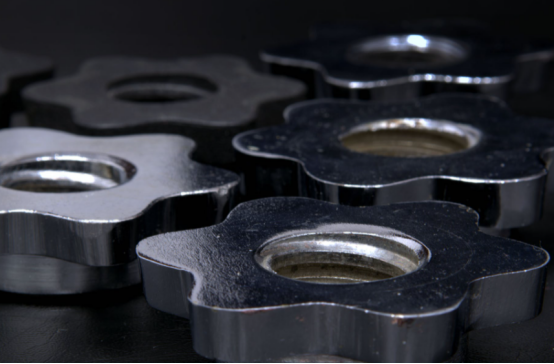① Degreasing
1. Function: Remove fatty oil stains and other organic dirt on the surface of the material to obtain a good electroplating effect and prevent pollution to subsequent processes.
2. Temperature control range: 40~60℃
3. Mechanism of action:
With the aid of the saponification and emulsification of the solution, the purpose of removing oil stains can be achieved.
The removal of animal and vegetable oils is mainly based on the saponification reaction. The so-called saponification is the process of chemical reaction between oil and the alkali in the degreasing liquid to produce soap. The oil that was originally insoluble in water is decomposed into soap and glycerin that are soluble in water, and then removed.
4. Matters needing attention:
1) Ultrasonic oscillation can enhance the degreasing effect.
2) When the concentration of degreasing powder is insufficient, the degreasing effect cannot be achieved; when the concentration is too high, the loss will be greater and the cost will increase, so it needs to be controlled within a reasonable range.
3) When the temperature is insufficient, the degreasing effect is not good. Increasing the temperature can reduce the surface tension of the solution and grease and accelerate the degreasing effect; when the temperature is too high, the material is prone to deformation. The temperature must be strictly controlled during operation.
4) After the degreasing process, the surface of the material should be completely wetted. If there is obvious repulsion between water droplets and the material interface, it means that the operation has not met the requirements. Repeat the operation and adjust the parameters in time.
②Swelling
Mechanism of action:
The swelling agent expands the workpiece to achieve surface micro-corrosion, while softening the material itself, releasing the uneven stress caused by injection molding or material, so that the subsequent roughening process can be uniformly and well corroded.
The method of checking the internal stress of the electroplating material will be different for different materials. For ABS, the glacial acetic acid dipping method is generally used.
③Coarsening
1. Temperature control range: 63~69℃
2. ABS plastic is a terpolymer of acrylonitrile (A), butadiene (B) and styrene (S). During the roughening process, the plastic particles are contained to form pits, making the surface hydrophobic to hydrophilic, so that the plating layer adheres to the plastic part and is firmly bonded.
Precautions:
1) High chromium solution has fast melting and coarsening speed and good coating adhesion; but when the value of chromic acid and sulfuric acid is greater than 800 g/L, the solution will precipitate, so it is necessary to keep gas stirring.
2) When the concentration is insufficient, the coarsening effect is poor; when the concentration is too high, it is easy to over-coarse, damage the material, and bring out large loss and increase the cost.
3) When the temperature is insufficient, the roughening effect is not good, and when the temperature is too high, the material is prone to deformation.
④Neutralization (the main component is hydrochloric acid)
1. Function: Clean the hexavalent chromium remaining in the micropores of the material after roughening and corrosion to prevent pollution to the subsequent process.
2. Mechanism of action: During the roughening process, the material rubber particles are dissolved away, forming pits, and there will be roughening liquid remaining inside. Because the hexavalent chromium ion in the roughening liquid has strong oxidizing properties, it will pollute the subsequent process. Hydrochloric acid can reduce it to trivalent chromium ions, thereby losing oxidizing properties.
3. Matters needing attention:
1) Hydrochloric acid is easy to volatilize, gas stirring can enhance the neutralization and cleaning effect, but the airflow is not easy to be too large, so as to avoid the loss of hydrochloric acid volatilization.
2) When the concentration is insufficient, the cleaning effect is poor; when the concentration is too high, the carry-out loss is greater and the cost increases.
3) The temperature rise can enhance the cleaning effect. When the temperature is too high, the volatilization loss will be large, which will increase the cost and pollute the air.
4) During use, trivalent chromium ions will accumulate and increase. When the liquid is dark green, it means that there are too many trivalent chromium ions and should be replaced regularly.
⑤ Activation (catalysis)
1. Function: Deposit a layer of colloidal palladium with catalytic activity on the surface of the material.
2. Mechanism of action: polymers containing active groups can form complexes with precious metal ions.
3. Precautions:
1) Do not stir the activating liquid, otherwise it will cause the activator to decompose.
2) The increase in temperature can increase the effect of palladium sinking. When the temperature is too high, the activator will decompose.
3) When the concentration of the activator is insufficient, the palladium precipitation effect is insufficient; when the concentration is too high, the carry-out loss is large and the cost increases.
⑥ Chemical nickel
1. Temperature control range: 25~40℃
2. Function: Deposit a uniform metal layer on the surface of the material, so that the material changes from a non-conductor to a conductor.
3. Matters needing attention:
1) Hypophosphorous acid is a reducing agent for nickel. When the content is high, the deposition speed will increase and the plating layer will be dark, but the stability of the plating solution will be poor, and will accelerate the generation rate of hypophosphite radicals, and the plating solution will be easy to decompose.
2) As the temperature increases, the deposition rate of the plating solution increases. When the temperature is too high, because the deposition rate is too fast, the plating solution is prone to self-decomposition and the solution life is shortened.
3) The pH value is low, the solution sedimentation speed is slow, and the sedimentation speed increases when the pH increases. When the PH value is too high, the coating is deposited too fast and not dense enough, and particles are prone to be produced.
Post time: Mar-27-2023

